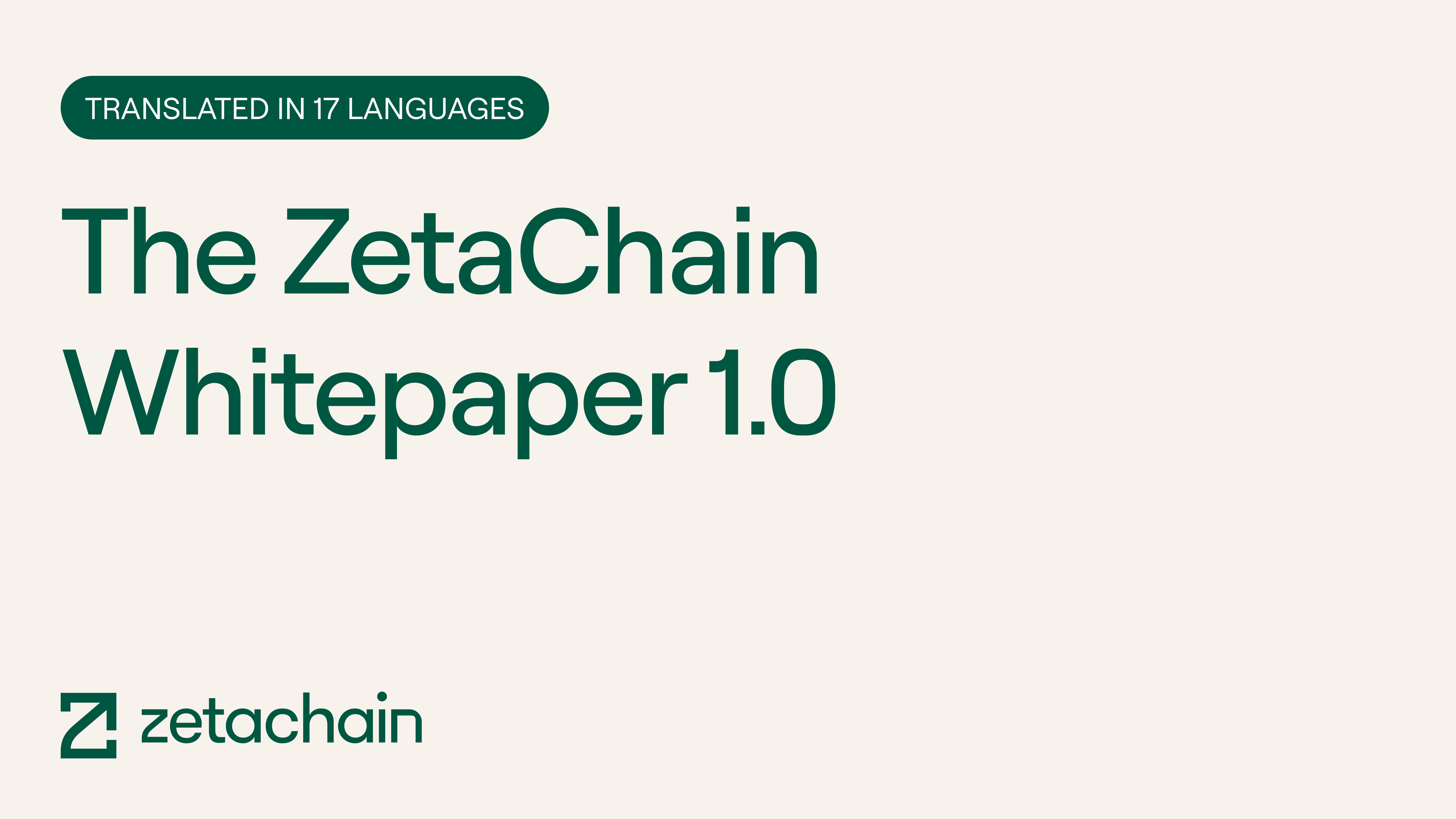Announcing the ZetaChain Whitepaper 1.0
Mar 28, 2025
ZetaChain Team
Check out this blog post in español, 简体中文, 繁體中文, 日本語, हिंदी, 한국인, tiếng-việt, deutsch, português, français, русский, українська, persian, türkçe, indonesian, and filipino (non-English translations are created by the community, not ZetaChain).
We are thrilled to deliver the final version of the ZetaChain whitepaper (translated in 17 languages). What remains consistent is ZetaChain’s unwavering mission to offer a public L1 blockchain with built-in interoperability to any chain — even non smart chains like Bitcoin. With this release, we’re proud to share the current version of ZetaChain delivers on the omnichain future proposed in the whitepaper. Most notably, the paper expands on the technicalities of Omnichain Smart Contracts, a transformative, new innovation in crypto, which we briefly summarize in this post. Accessibility is important so we invite you to find the full whitepaper in your local language:
Omnichain Smart Contracts (Section 4.4)
Omnichain Smart Contracts can access and manage assets and data on connected networks from a single point of logic. They are hosted on ZetaChain’s ZetaEVM (zEVM) module, which supports all EVM features and interactions in addition to the following:
Contracts on zEVM can be called from external chains
Contracts on zEVM can generate outbound transactions on external chains
These two additional features make the zEVM a general purpose programmable platform that supports the concept of cross-chain transactions that alter states in different chains atomically and in a single step. Said simply, this means developers can leverage the existing robust Ethereum smart contract ecosystem to build truly interoperable applications on top of ZetaChain — as if everything were on a single chain. Visit our developer resources to get started.
Key Differences from Message Passing (Section 4.4.4)
Developers can build on ZetaChain using both synchronous (Omnichain Smart Contracts) and asynchronous (Cross-Chain Messaging) architectures, or a combination of both. Both mechanisms can support many types of applications, but they offer fairly significant differences from an app-building architecture standpoint. At a high-level, let’s review three important ways Omnichain Smart Contracts differ.
Synchronous Multichain Development
Omnichain Smart Contract application logic and state lives in a single place (figure 5). On the other hand, messaging involves broadcasted messages and state sync across many contracts on different chains, which can lead to more attack surface and more gas fees (and this can scale quickly). For example, managing a vault or lending protocol with assets across many chains would be difficult to manage with just messaging.
Omnichain smart contract-based application. Note that there is a single contract that receives input, writes output, maintains state, and orchestrates external assets for the application.
Easily Redeploy Existing Ethereum dApps
Common, battle-tested Ethereum applications like Uniswap V2/V3, Curve, Aave, Compound, and others can be deployed as Omnichain Smart Contracts with minimal change. ZRC-20 support enables single-step transactions like Ethereum (but natively cross-chain). Messaging (especially for complex apps) requires recreating logic in a completely different, asynchronous messaging and state-sync system; messaging cannot leverage existing work in the same way.
First-Ever Bitcoin Smart Contracts
ZRC-20 can easily support Bitcoin/Cardano/XRP, which do not support general purpose smart contracts for applications like swapping, lending, Etc. So, for example, Omnichain Smart Contracts can orchestrate native BTC on the Bitcoin network together with assets in the DeFi world. Messaging cannot work for these chains because messaging requires smart contracts on any connected chain.
Start Building
Our Developer Resources page is now live. Here, you can find our ZetaDocs and more information about how to join our developer program.
About ZetaChain
ZetaChain is the world’s first and only decentralized L1 blockchain with built-in cross-chain interoperability, connecting all blockchains, even non-smart contract chains like Bitcoin and Dogecoin. With ZetaChain’s complete Omnichain toolkit, developers can build true omnichain dApps from a single point of logic, and users can access all of their assets, data, and liquidity in a single place, securely.
Follow ZetaChain on Twitter @zetablockchain and join the conversation on Discord and Telegram. Reach out to [email protected] if you’re building on top of ZetaChain.
Categories
Related Posts
$5 Million ZetaChain Grants Program for Omnichain dApp Builders
We are thrilled to announce the launch of our ZetaChain Grants Program to support innovative, decentralized businesses that help grow the ZetaChain ecosystem.
ZetaChain Partners with Ankr To Accelerate Access To Web 3 Infrastructure
Announing our partnership with Ankr Protocol, one of the world’s leading web3 infrastructure providers and first ZetaChain RPC (Remote Procedure Call) partner.
